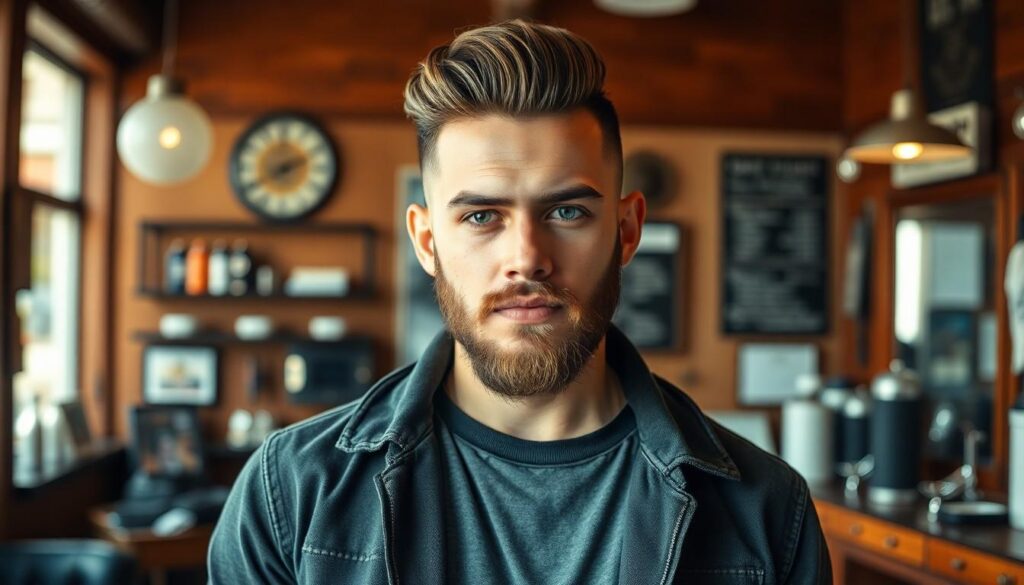Looking for a hairstyle that’s both modern and timeless? The faded undercut might be exactly what you’re seeking. This versatile cut combines the clean precision of an undercut with the smooth gradient of a fade, creating a look that’s sharp, stylish, and incredibly popular among men of all ages.
We’ve seen the faded undercut dominate barbershops across the country, and for good reason. It’s customizable to any hair type, works with various face shapes, and can be styled in countless ways—from sleek professional looks to edgy weekend styles. Whether you’re considering this cut for the first time or looking to refresh your current style, understanding the nuances of a proper faded undercut will ensure you get exactly what you want at your next appointment.
The Evolution of the Faded Undercut Hairstyle
The faded undercut has transformed dramatically from its utilitarian beginnings to becoming one of today’s most sought-after men’s hairstyles. Originating in the early 20th century, this style initially served practical purposes among military personnel and factory workers who needed hair that wouldn’t interfere with helmets or machinery. Military barbers popularized the undercut during Industry War I and II, creating a functional style that kept soldiers cool while maintaining a professional appearance.
During the 1980s, the style began its transformation into a fashion statement when punk and new wave musicians adopted variations of the undercut to express rebellion. David Bowie and other influential artists showcased more extreme versions, helping to transition the cut from purely practical to culturally important. Barbers started incorporating fading techniques that had been perfected in traditional barbershops, merging them with the sharp undercut to create a more graduated and sophisticated look.
The 2010s marked the modern renaissance of the faded undercut when celebrities like David Beckham, Brad Pitt, and Justin Timberlake embraced the style, catapulting it into mainstream popularity. Television shows such as “Peaky Blinders” further cemented the faded undercut in popular culture, with Thomas Shelby’s iconic haircut becoming a reference point for barbers worldwide. Social media platforms accelerated this trend, with Instagram and Pinterest becoming digital lookbooks for men seeking inspiration for their next haircut.
Today’s faded undercut represents the culmination of barber expertise, incorporating precision fading techniques that range from skin fades to drop fades. Contemporary versions offer unprecedented versatility, allowing for personalization through varying fade heights, disconnection levels, and top length options. Barbers now blend traditional techniques with modern styling approaches, creating cuts that work for corporate environments yet transform for weekend adventures.
Cultural influences continue to shape the evolution of this hairstyle, with K-pop idols, sports stars, and fashion influencers adding their unique interpretations. The modern faded undercut stands as a testament to how a functional haircut can evolve into an art form, representing the perfect marriage between traditional barbering and contemporary style preferences.
Understanding What Makes a Perfect Faded Undercut
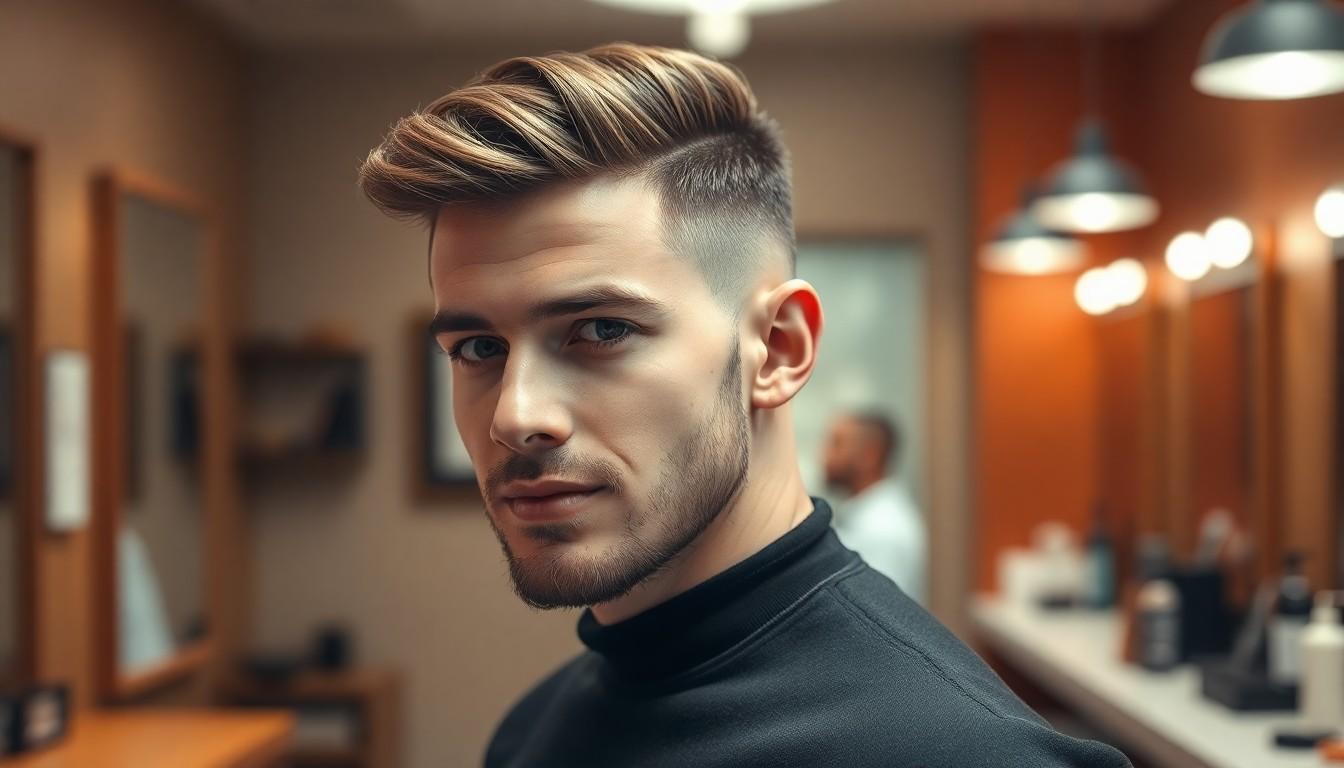
A faded undercut combines the best elements of two classic haircuts into one sophisticated style. This versatile cut features longer hair on top with shorter sides that blend seamlessly through a fade technique, creating a polished yet edgy appearance.
The Key Elements of a Classic Faded Undercut
The perfect faded undercut consists of three essential components that work together to create this distinctive style:
- Top Hair Length – The crown area maintains longer hair that can be styled in various ways, from side-parted looks to center parts, depending on your preference and face shape.
- Short Sides and Back – The hallmark of this cut involves significantly shorter hair on the sides and back, creating a striking contrast with the longer top section.
- Seamless Blend – Unlike traditional undercuts with harsh lines, the faded variation features a gradual transition between the longer top and shorter sides, achieved through careful tapering techniques.
- Regular Maintenance – This style requires consistent upkeep to maintain its defined look, with most barbers recommending touch-ups every 2-3 weeks to keep the fade crisp.
Different Types of Fades for Your Undercut
Choosing the right fade type dramatically impacts your overall look. Here are the most popular fade variations to consider:
- Low Fade – Starting just above the ears, this subtle transition offers a clean, professional appearance without dramatic contrast. Low fades work exceptionally well in conservative workplaces while still providing stylish definition.
- Mid Fade – Beginning at the midpoint between the ear and temple, this balanced option provides more noticeable tapering while maintaining versatility. Mid fades particularly suit men in creative and technology industries.
- High Fade – Starting near the temple area, this bold style creates maximum contrast between the top and sides. High fades make a fashion-forward statement and draw attention to the styled top section.
- Skin Fade – Also called a bald fade, this technique gradually blends hair down to the skin for an ultra-clean, modern appearance. Skin fades require the most frequent maintenance but deliver the sharpest contrast.
- Temp Fade – Focusing specifically on the temple area, this variation adds a unique edge to the traditional undercut by creating precise definition around the hairline and sideburns.
- Taper Fade – Featuring a more gradual decrease in length, taper fades offer a subtler transition that works well for those wanting a refined look without dramatic contrast.
10 Most Popular Faded Undercut Variations to Try in 2023
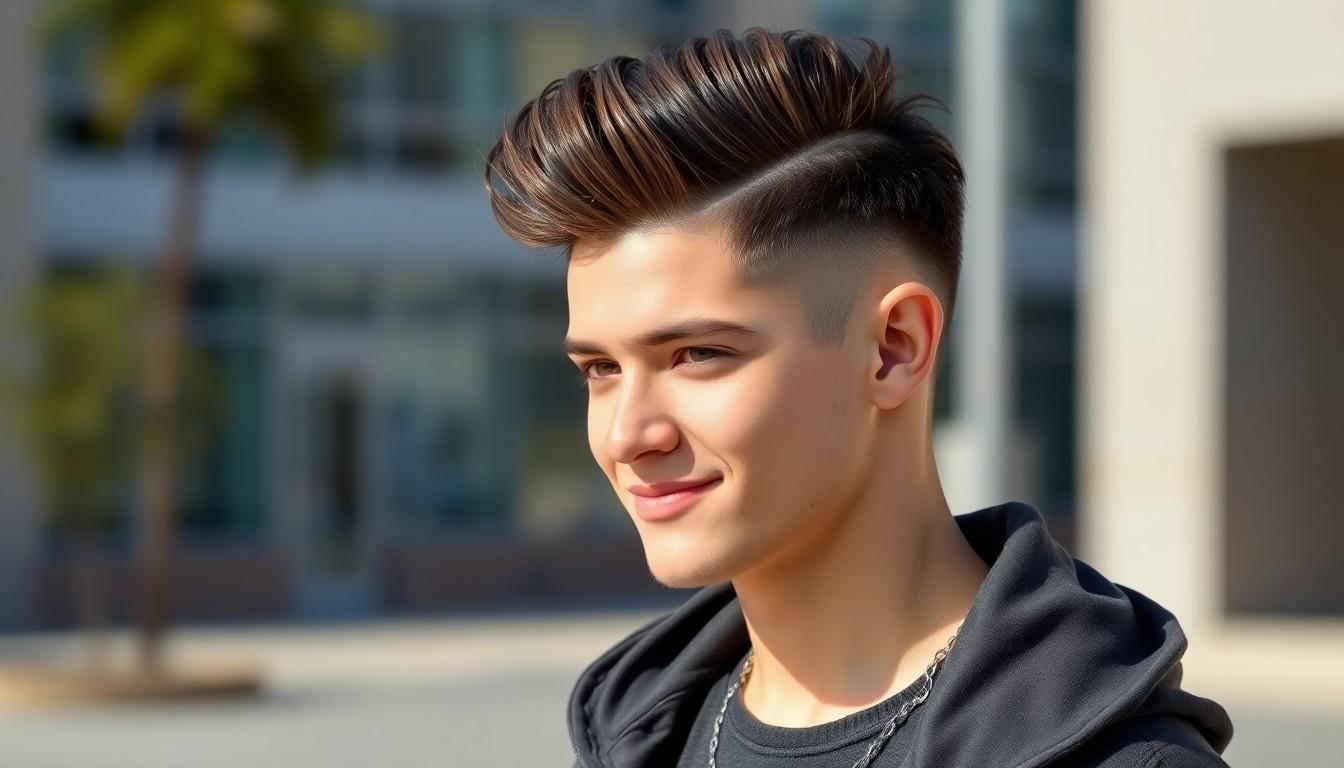
High Fade Undercut
High fade undercuts create dramatic contrast by fading the hair on the sides and back up to eye level while maintaining longer hair on top. This bold style makes a statement with its sharp transition between the faded sides and the fuller top section. Many style enthusiasts opt for slicking the top hair back to achieve a sleek, polished appearance that works well in both professional and casual settings.
Low Fade Undercut
Low fade undercuts start the gradual fade around the temples or ears, preserving more hair on the sides compared to higher fades. This subtle variation offers a clean, defined look without being too extreme. Men with rounder face shapes often find this style particularly flattering as it maintains some volume on the sides while still providing the fresh, customized aesthetic of a faded undercut.
Mid Fade Undercut
Mid fade undercuts balance the dramatic high fade and the subtler low fade by beginning the graduation midway between the temples and ears. This versatile option works with many styling choices for the top section. Barbers typically recommend mid fades for clients seeking a noticeable fade effect that isn’t too extreme for conservative environments yet still delivers a contemporary appearance.
Skin Fade Undercut
Skin fade undercuts (also called bald fades) shave the sides and back almost completely while keeping the top hair longer for maximum contrast. This sharp, crisp look requires more frequent maintenance to preserve its clean lines and seamless graduation. Clients should schedule touch-ups every 2-3 weeks to maintain this high-impact style that commands attention in any setting.
Taper Fade Undercut
Taper fade undercuts feature a gradual decrease in hair length without any harsh lines of demarcation for a more natural transition. This style blends seamlessly into the skin, creating a refined look that’s suitable for professional environments. Men seeking a more subtle interpretation of the faded undercut often prefer this variation for its sophisticated, understated elegance.
Textured Top Faded Undercut
Textured top faded undercuts combine shorter sides with deliberately tousled, layered hair on top for added dimension and movement. This modern style uses styling products to enhance volume and create that desirable “undone” appearance. Men with fine or straight hair particularly benefit from this variation as the added texture creates the illusion of thicker, fuller hair.
Pompadour Faded Undercut
Pompadour faded undercuts style the top hair upward and backward away from the face with important volume, contrasting dramatically with cleanly faded sides. This bold combination merges vintage inspiration with contemporary execution for a head-turning style. Styling products with strong hold are essential for maintaining the height and structure of the pompadour throughout the day.
Slicked Back Faded Undercut
Slicked back faded undercuts create a refined appearance by combing the longer top hair straight backward while maintaining precisely faded sides. This classic, polished style works exceptionally well for formal occasions and professional settings. Hair cream or gel helps achieve the sleek finish that defines this sophisticated variation of the faded undercut.
Curly Top Faded Undercut
Curly top faded undercuts embrace natural texture by keeping curls intact on top while creating clean, faded sides for an eye-catching contrast. This style celebrates natural hair patterns while maintaining a structured, contemporary silhouette. Light-hold styling products help define curls without weighing them down, allowing for movement and bounce that enhances this ever-changing look.
Disconnected Faded Undercut
Disconnected faded undercuts feature a deliberate lack of blending between the longer top section and the faded sides, creating a bold, edgy aesthetic. This dramatic style makes a strong fashion statement with its intentionally stark contrast between different hair lengths. Men who want to showcase their personal style and aren’t afraid of more attention-grabbing looks gravitate toward this distinctive variation.
How to Communicate With Your Barber for the Perfect Faded Undercut
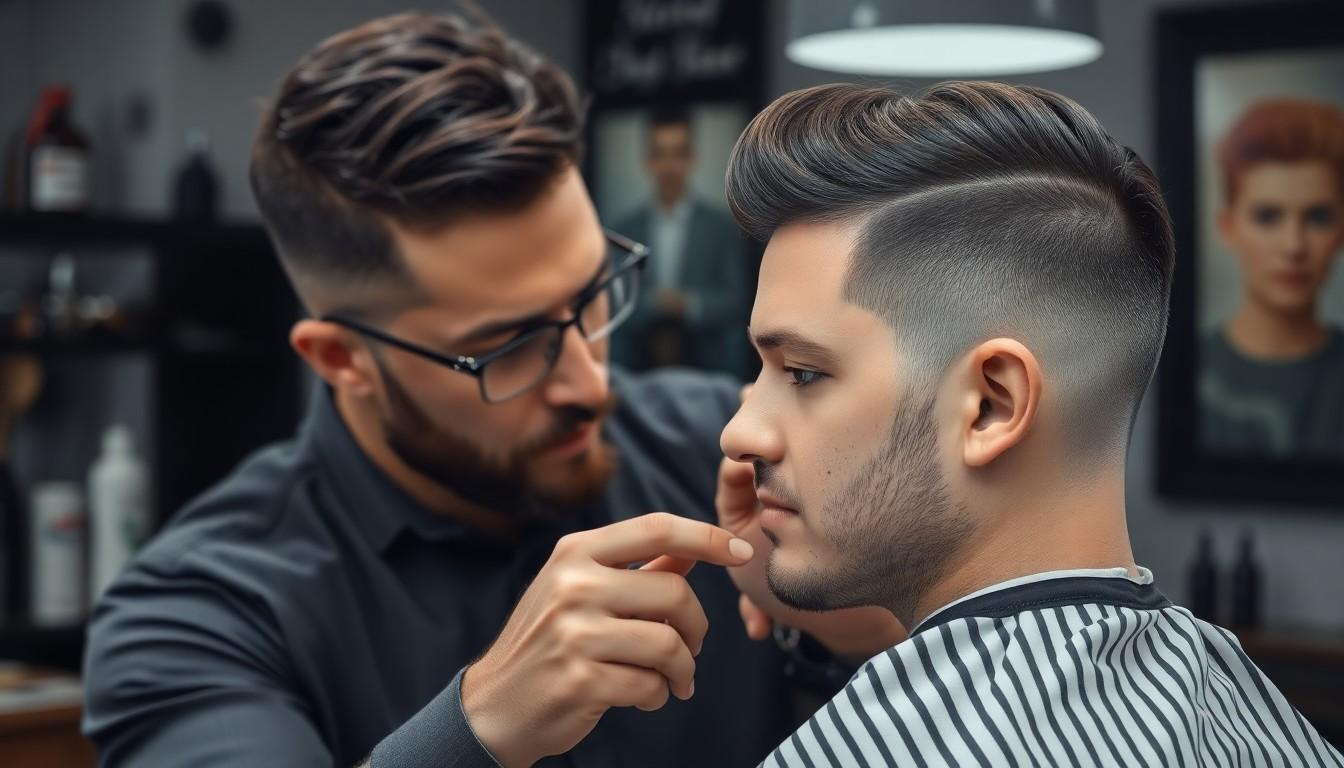
Getting your ideal faded undercut requires clear communication with your barber. Knowing exactly how to express what you want can make the difference between walking out with your dream cut or facing weeks of disappointment.
Essential Terminology to Know
- Types of Fades – Familiarize yourself with the different fade variations before your appointment. Low fades start below the temples and ears for a subtle look. Mid fades begin at the temples and ears, offering a balanced appearance. High fades start above the temples and ears, creating a more dramatic contrast. Skin fades cut hair very close to the skin for a sharp look. Bald fades take it a step further, cutting even closer to the skin than a standard skin fade.
- Undercut Definition – Be clear about what an undercut actually means—cutting the hair on the underside of the head, typically from the temples back, while maintaining longer hair on top. This knowledge ensures you’re both talking about the same style.
- Clipper Guard Numbers – Learn basic clipper guard sizes to specify exactly how short you want certain areas. Guards typically range from 0 (shortest) to 8 (longest), with each number representing approximately 1/8 inch in length.
- Blending Techniques – Understanding terms like “scissor over comb” helps communicate how you want the transition between your undercut and top section to appear. This technique creates a more natural, seamless blend rather than a harsh line.
- Top Length Specifications – Use finger measurements or actual length in inches to indicate how much hair you want to keep on top. Simply saying “short” or “long” can be interpreted differently by different barbers.
Visual References to Bring Along
- Multiple Style Photos – Collect several pictures showing your desired fade type from different angles. Front, side, and back views provide your barber with a complete understanding of your vision.
- Previous Haircut Pictures – Bring photos of yourself with a previous haircut you liked, particularly if the same barber didn’t cut it. These images demonstrate how your exact hair type responds to certain styles.
- Celebrity References – Screenshots from celebrities or influencers with similar hair texture to yours offer realistic examples of how the style might look on you. Famous figures often showcase well-executed faded undercuts that barbers recognize.
- Detail Close-ups – Include close-up images highlighting exact elements you like, such as the fade transition point, the texture on top, or how the hair is styled. These details help your barber focus on the aspects most important to you.
- Styling Variations – Show pictures of how you plan to style your hair daily, whether slicked back, textured, or parted. This information helps your barber cut the top length appropriately for your preferred styling method.
- Personalized Mood Board – Create a digital collection of styles you like and dislike to give your barber context about your personal taste. This broader perspective helps them customize the cut to suit your overall aesthetic.
Maintaining Your Faded Undercut Between Barber Visits
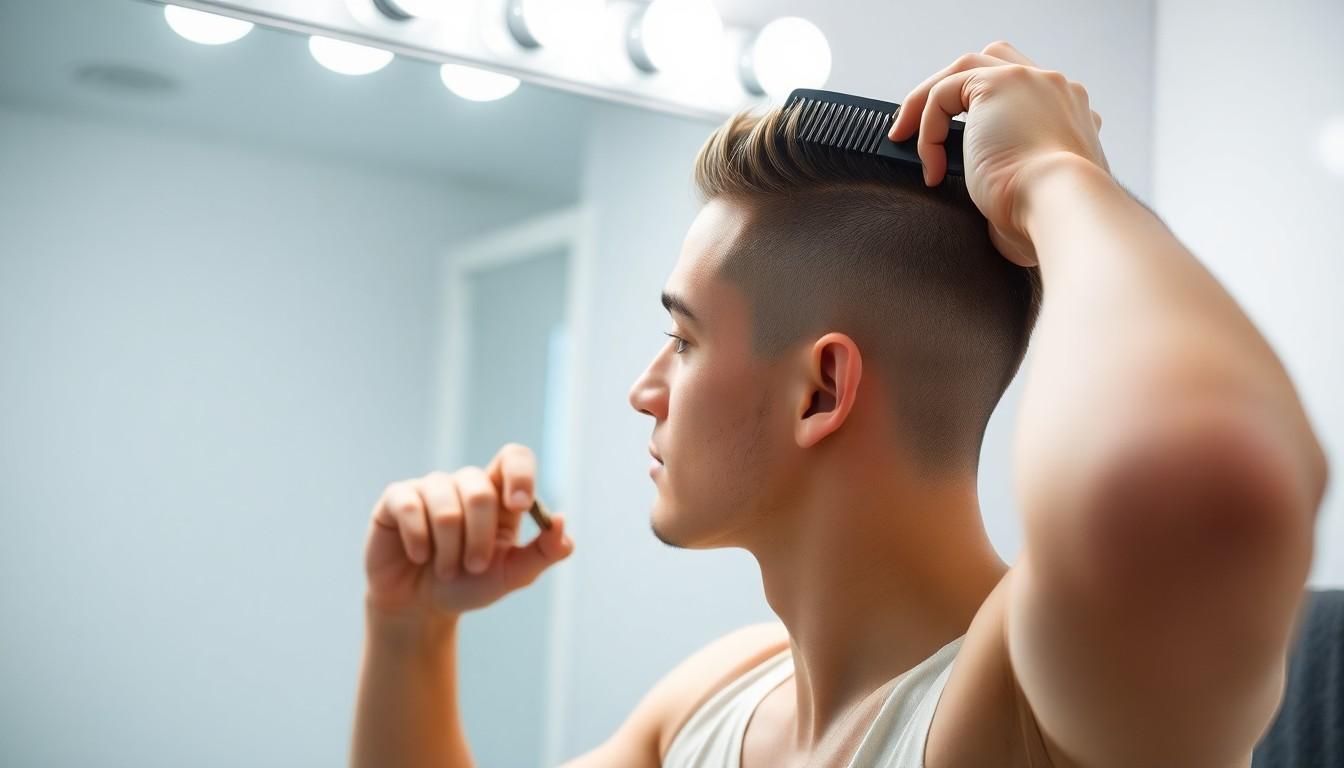
Keeping your faded undercut looking fresh doesn’t stop when you leave the barber’s chair. Regular maintenance is essential to preserve that clean, defined look until your next appointment.
Daily Styling Tips and Techniques
- Use quality styling products to maintain the shape and texture of your longer top hair. We recommend applying a small amount of pomade, gel, or styling cream that matches your hair type and desired hold level.
- Style with proper tools like a comb or brush to keep the top section looking neat, especially if you have textured or choppy layers that need regular shaping.
- Touch up your fade weekly using a trimmer without a guard to clean up the edges and maintain that crisp fade line between appointments.
- Work with dry hair when doing any clipper maintenance at home. Dry hair allows you to see the shape develop more clearly and prevents hair from sticking to your clippers.
- Master the clipper over comb technique to blend and taper sections for a smoother transition between the shorter sides and longer top.
- Schedule regular barber visits every 2-4 weeks to maintain your fade’s definition and prevent uneven growth that can quickly diminish your style.
Recommended Products for Different Faded Undercut Styles
For a Polished Look
- High-hold pomades from brands like Uppercut Deluxe or Hanz de Fuko provide lasting control for structured styles
- Hair wax offers strong hold with a natural-looking finish while adding definition to your longer top section
For a Textured Look
- Texturizing spray adds volume and creates separation in the hair strands for that effortlessly tousled appearance
- Sea salt spray enhances natural texture and provides light hold with a matte finish that works perfectly for casual styles
For a Colored Look
- Color-protecting shampoo and conditioner preserve vibrancy in platinum blonde or bold-colored undercuts
- Color-improving products such as depositing masks maintain your color between salon visits and prevent premature fading
For a Faded Undercut with Designs
- Quality shaving cream and sharp razors create precise lines when refreshing design elements in your fade
- Adjustable guard trimmers help maintain intricate patterns without accidentally cutting too short or altering the original design
Styling Your Faded Undercut for Different Occasions
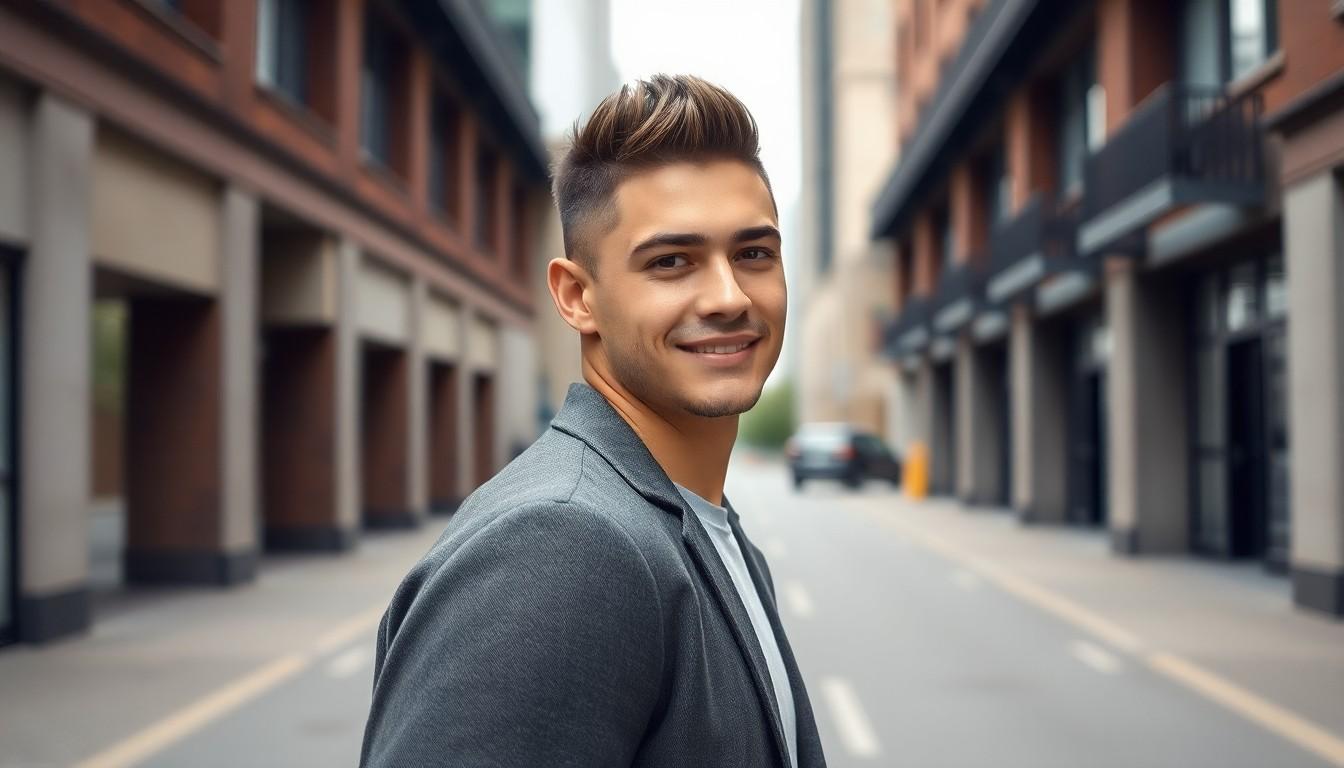
The versatility of a faded undercut makes it perfect for various settings. Let’s explore how to style this popular cut for different occasions in your life.
Casual Everyday Looks
Achieving a relaxed yet stylish appearance with your faded undercut requires minimal effort for daily wear. Add texture to the top hair using light hold styling products or texturizing sprays for that natural, effortless look. Short spikes or messy, piecey layers pair exceptionally well with low or mid fades, creating that laid-back vibe perfect for everyday activities. Maintain ease by applying light hold wax or pomade to keep hair in place without appearing overly styled. This approach delivers a casual style that looks intentional but not fussy—ideal for running errands, meeting friends, or just enjoying your day.
Professional Office-Ready Styles
Transform your faded undercut into an office-appropriate style by focusing on a polished, neat appearance. Opt for a low fade undercut variation, which adds charm and good vibes to your professional look without crossing into territory that’s too bold for workplace settings. Style the top hair using medium to firm hold products to ensure it stays neat and properly positioned throughout your workday. Side parts or sleek back looks create particularly office-friendly appearances that maintain professionalism. Avoid excessive texture or messiness on top—instead, create a clean, styled finish that communicates attention to detail and professional demeanor during important meetings or presentations.
Special Event Styling Options
Elevate your faded undercut for special occasions with more creative and eye-catching styling choices. Consider incorporating bold textures or layers on top, such as choppy layers or a dramatic pompadour, adding extra dimension that stands out in formal or celebratory environments. Apply firm hold wax or gel to define your hair and ensure it remains perfectly styled throughout extended events—a technique particularly effective with high fade undercuts. Make a statement by experimenting with bold colors or shaved patterns on the short sides, creating unique and attention-grabbing designs for nightlife or artistic gatherings. Pair your high fade undercut with a well-groomed beard for sophisticated occasions, highlighting your facial features including jawline, cheekbones, and overall symmetry for a complete, refined look that’s sure to impress.
Celebrities Rocking the Faded Undercut Trend

The faded undercut has become a signature style for many high-profile celebrities who continue to influence men’s hairstyle trends worldwide. Hollywood stars and musicians have embraced this versatile cut, adding their personal flair while showcasing its adaptability. Let’s look at some of the most notable celebrities who’ve made the faded undercut their go-to hairstyle.
Brad Pitt
Brad Pitt’s relationship with the faded undercut has significantly boosted the style’s popularity in mainstream culture. The Oscar-winning actor has sported various versions of this cut throughout his career, particularly in films like “Fury” where his military-inspired undercut with a clean fade became instantly iconic. His approach to the style often features a slightly longer top with a perfectly executed fade on the sides, creating a versatile look that works for both casual appearances and red carpet events.
Justin Timberlake
Justin Timberlake has consistently remained at the forefront of men’s style trends, including his adoption of the faded undercut. The multi-talented performer typically wears his undercut with a more pronounced fade that creates a sleek, modern silhouette. Timberlake’s version often includes textured styling on top, demonstrating how versatile the cut can be for different hair types and personal preferences. His polished interpretation has made the style accessible for men looking for a hairstyle that transitions seamlessly from day to night.
Zac Efron
Zac Efron’s youthful take on the faded undercut has resonated with younger audiences looking to adopt this trendy style. The actor frequently showcases how this cut can complement a more active lifestyle while maintaining a fashion-forward appearance. Efron’s approach typically features a higher fade with more volume on top, creating a dramatic contrast that highlights his facial features. His styling choices have demonstrated the cut’s versatility for different face shapes and personal aesthetics.
Other Notable Celebrities
The faded undercut’s versatility has made it a favorite among celebrities from various entertainment fields. Sports stars, musicians, and actors have all embraced different variations of this cut, adapting it to suit their personal style and professional image. The fade element adds a modern edge to the traditional undercut, making it appropriate for various settings from casual appearances to formal events. This widespread adoption across different celebrity circles has helped cement the faded undercut as more than just a passing trend but a staple in men’s hairstyling.
Common Mistakes to Avoid With Your Faded Undercut
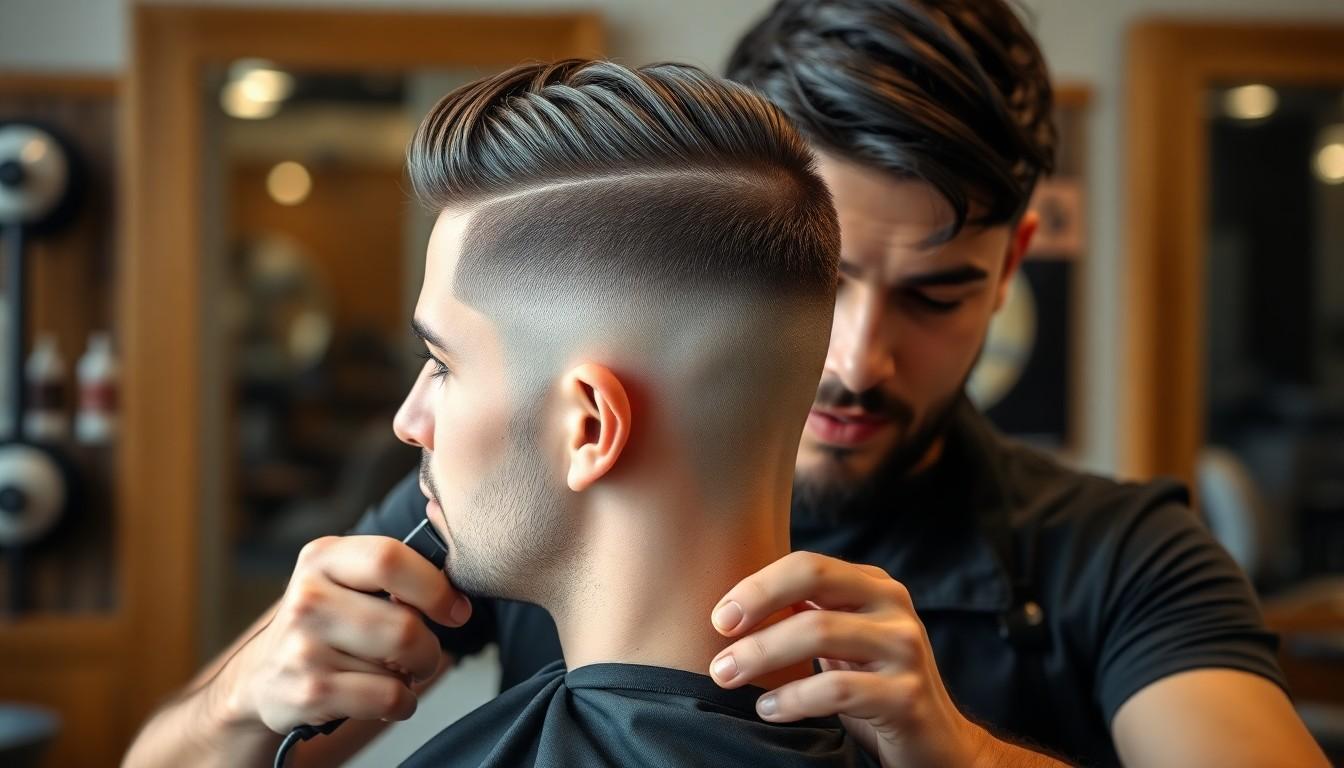
Uneven or Jagged Parting
An uneven parting line can instantly ruin the clean aesthetic of your faded undercut. This common mistake creates a visibly unprofessional look that draws attention for all the wrong reasons. Professional barbers recommend waiting for the hair to grow out if the mistake is severe, then having it corrected during your next appointment. We’ve found that using a mirror to check the back of your head during home touch-ups can help prevent this issue before it becomes noticeable.
Creating Hard Lines
Hard lines occur when clippers aren’t handled properly during the fading process. Many people make the mistake of turning their clippers upside down or cutting straight up, which creates harsh, unblended transitions. To achieve a seamless fade, always keep your clippers right side up and use a flicking motion as you approach the guide line. The goal is to create a gradual blend rather than distinct sections that look disconnected from each other.
Going Too Fast and Missing Steps
Rushing through a faded undercut often leads to disappointing results. Skipping crucial steps like creating proper guide lines or not taking time to blend between different lengths can leave you with an uneven, unprofessional look. Taking your time ensures each section receives proper attention, resulting in a clean, well-executed fade. Patience during the cutting process pays off with a more polished final appearance.
Incorrect Clipper Technique
Using improper clipper angles creates visible lines and uneven transitions. The technique matters significantly—cutting straight up instead of at an angle is a recipe for a choppy fade. Proper execution requires moving the clippers up and out at an angle, creating a natural graduation between lengths. This technique helps achieve that sought-after seamless blend that distinguishes professional fades from amateur attempts.
Lack of Blending
Failing to blend the different lengths properly results in a disjointed appearance rather than a smooth fade. This mistake happens when there’s an abrupt change between hair lengths instead of a gradual transition. Professional barbers focus on creating a seamless progression by gradually decreasing hair length as they move up the head. The key to a successful faded undercut lies in this careful blending technique that eliminates any harsh transitions between the shorter and longer sections.
How to Know if a Faded Undercut Will Suit Your Face Shape
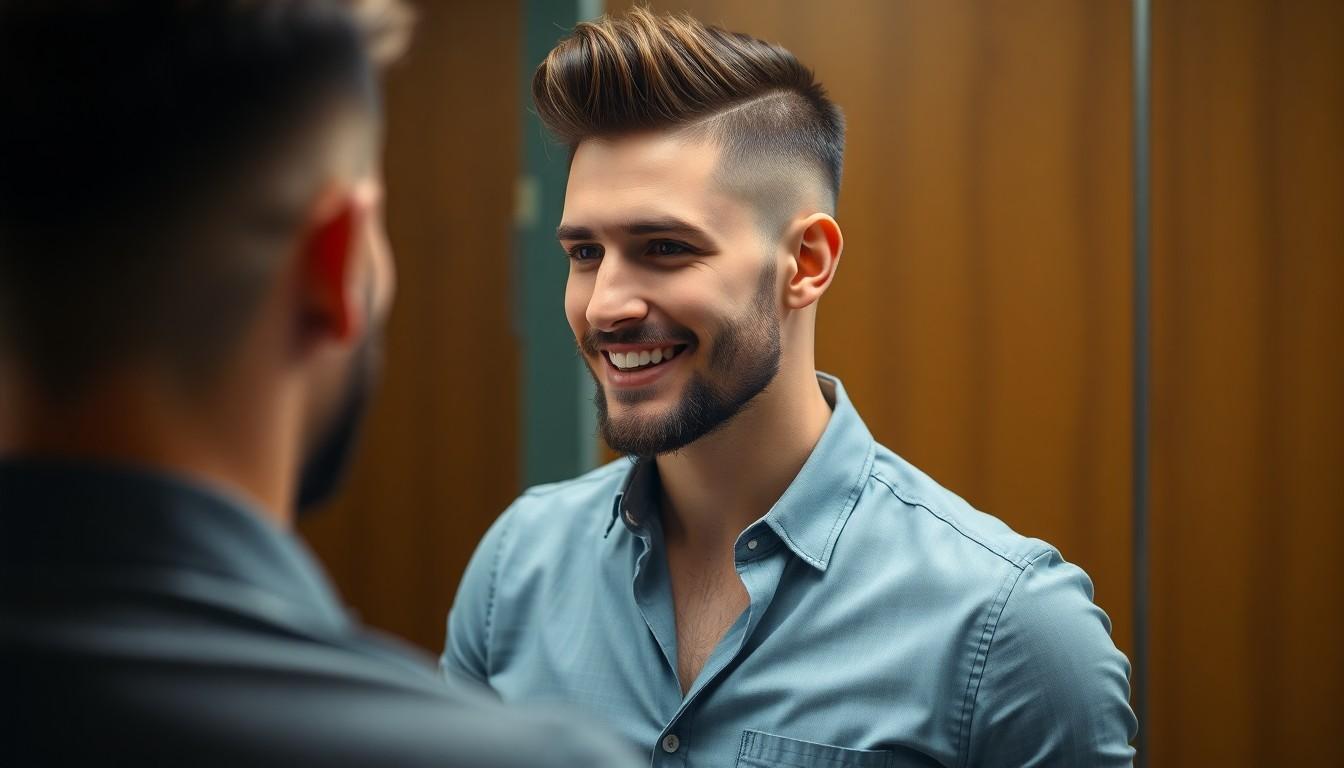
The faded undercut can transform your appearance, but understanding how it works with your unique face shape is crucial for achieving the best results. We’ve compiled a comprehensive guide to help you determine if this versatile style will complement your features.
Round Face Shape
Round faces benefit significantly from a faded undercut’s structure and contrast. The style creates vertical lines that effectively elongate your face shape, making it appear less circular and more defined. Adding volume and height on top while keeping the sides tight with a fade will create a slimming effect for your cheeks and jawline. This style works particularly well when the top is styled upward to maximize the lengthening effect.
Oval Face Shape
If you have an oval face, consider yourself lucky! Oval face shapes accommodate virtually any variation of the faded undercut due to their naturally balanced proportions. You can experiment with different fade heights and top lengths without worry. The natural symmetry of your face provides the perfect canvas for both dramatic high fades and more subtle low fades, depending on your personal style preferences.
Square Face Shape
Square faces pair excellently with faded undercuts when styled correctly. The key is creating balance by softening your angular jawline and forehead. Opt for a style that maintains some texture and volume on top while implementing a clean fade on the sides. This combination helps round out the sharp angles of your face while maintaining a masculine, structured look that complements your strong features.
Oblong (Rectangular) Face Shape
For oblong faces, the primary concern is avoiding additional height that might make your face appear longer. We recommend choosing a low or mid fade rather than a high fade to maintain balanced proportions. Keep the styling on top relatively flat or swept to the side instead of adding vertical volume. This approach prevents elongating your face further while still giving you the clean, modern aesthetic of a faded undercut.
Diamond Face Shape
Diamond face shapes feature narrow foreheads and jawlines with wider cheekbones, creating a perfect opportunity for creative styling. Your face shape can handle dramatic styling on top, making it ideal for pompadours or textured quiffs paired with a faded undercut. Low to mid fades work best as they add perceived width to the sides of your head, balancing your prominent cheekbones and creating harmony throughout your features.
Hair Type and Maintenance Considerations
Your hair texture plays a important role in how a faded undercut will look. Thick hair provides natural volume and texture that enhances the contrast between the longer top and faded sides. Fine hair may require additional product for definition. Remember that regardless of hair type, maintaining the crisp lines of a faded undercut requires regular trims every 2-3 weeks to preserve the defined contrast that makes this style so appealing.
Styling Versatility
Faded undercuts offer remarkable versatility across all face shapes through proper styling. For a bold statement look, pair your fade with a dramatic pompadour or textured quiff that creates maximum contrast. Professional environments might call for a more refined approach with a smoother blend in the fade and a neatly combed or slicked top. The adaptability of this style means you can adjust it to suit your face shape and personal aesthetic with minimal effort.
Conclusion: Why the Faded Undercut Remains a Timeless Choice
The faded undercut stands as one of the most adaptable and enduring men’s hairstyles for good reason. We’ve seen how this versatile cut seamlessly blends classic barbering with contemporary style while accommodating diverse hair types face shapes and personal preferences.
Whether you’re drawn to the polished professionalism of a low fade or the bold statement of a disconnected variation there’s a faded undercut that perfectly expresses your individual style. With proper maintenance regular touch-ups and the right styling products you’ll keep your cut looking sharp between barber visits.
Remember that communication with your barber is key to achieving your desired look. By understanding the terminology and bringing references you’ll ensure your faded undercut enhances your features and fits your lifestyle perfectly. This iconic style isn’t just a haircut—it’s a personal statement that continues to evolve while remaining effortlessly cool.
Frequently Asked Questions
What is a faded undercut hairstyle?
A faded undercut combines longer hair on top with shorter sides and back that gradually blend (fade) from shorter to longer. This modern yet timeless style features precise tapering techniques that create a seamless transition between the different lengths, offering versatility for men of all ages and style preferences.
How often should I get my faded undercut trimmed?
You should get your faded undercut trimmed every 2-4 weeks to maintain its crisp, defined look. The fade tends to lose its clean appearance as hair grows, so regular maintenance is essential. For those with faster hair growth, aim for touch-ups closer to the 2-week mark to keep your style looking sharp.
What are the different types of fades available?
The main fade types include low fade (starting just above the ears), mid fade (beginning at the temples), high fade (starting near the crown), skin fade (blending down to bare skin), temp fade (focusing around the temples), and taper fade (a more gradual, subtle transition). Each creates a different look and level of contrast.
How do I communicate with my barber to get the perfect faded undercut?
Bring visual references to show exactly what you want. Learn essential terminology like fade types (high, mid, low, skin) and clipper guard numbers. Clearly describe how you want the top styled and the level of contrast desired. Discuss whether you want a disconnected or connected style for the most accurate results.
Can I maintain my faded undercut at home between barber visits?
Yes, you can maintain your faded undercut at home with the right tools. Use quality clippers with appropriate guards to touch up the faded areas using the clipper over comb method. Focus on keeping the neckline and around the ears clean. However, be cautious—major reshaping is best left to professional barbers.
Which faded undercut style works best for my face shape?
For round faces, try a high fade with textured top to add height. Oval faces can wear virtually any fade style. Square faces look great with low to mid fades that keep some bulk on the sides. Oblong faces benefit from low fades with volume on top. Diamond faces work well with mid fades that add width at the temples.
How do I style my faded undercut for different occasions?
For casual settings, use light hold products for a relaxed, textured look. In professional environments, opt for a clean, polished style with pomade or styling cream. For special events, consider more dramatic styling like a bold pompadour or slicked-back look. The versatility of the faded undercut allows for easy adaptation across occasions.
What products do I need for styling a faded undercut?
Essential products include a quality pomade or styling cream for hold and shine, texturizing powder or sea salt spray for volume and texture, hair clay for matte finishes, and a light hairspray for all-day hold. Choose products based on your desired finish (matte vs. shiny) and the level of hold needed.
Can curly or wavy hair work with a faded undercut?
Absolutely! Curly and wavy hair creates an attractive contrast with the faded sides. Keep the top longer to showcase your natural texture while maintaining the clean fade on the sides. This combination often requires less daily styling and can result in a distinctive, eye-catching look that highlights your natural hair pattern.
What are common mistakes to avoid with a faded undercut?
Avoid creating uneven partings, harsh lines, or rushing through maintenance. Don’t use incorrect clipper techniques or neglect proper blending between sections. When styling, avoid using too much product, which can make the hair look greasy or weighed down. Finally, don’t skip regular maintenance appointments with your barber.

